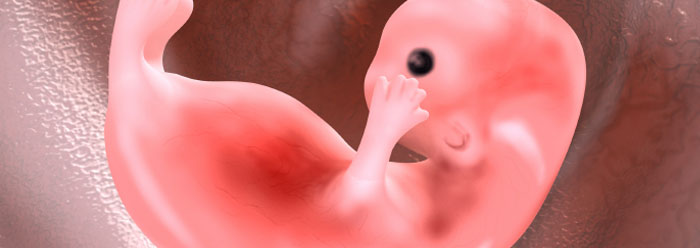German zoologist Ernst Haeckel is perhaps most famous for defending evolution with the argument that creatures replay their evolutionary past when developing in the womb. Since Darwin's time, textbooks have reiterated that early embryos of many vertebrates, including humans, have tiny pouches that reflect an evolutionary fish stage. More recently, embryologists thoroughly refuted that concept, and others have shown that Haeckel's drawings were partially faked. And a new online video taken from 3-D scans of a developing baby's face should bury Haeckel's old and uninformed argument.
Embryologist and evolutionist Michael Richardson and colleagues dropped a bomb on Haeckel's long-held concept known as "embryonic recapitulation." He compared Haeckel's old drawings with actual photographs of the same embryos in a 1997 technical paper.1 The comparison showed that Haeckel's drawings were frauds.
Richardson's report revealed that in order to make animal embryos look more similar at a certain early stage of development, Haeckel had omitted limb buds and heart bulges and resized and selected certain creature's embryos.2 Since Haeckel had to manipulate data to conform it to his evolutionary notions, then perhaps embryos—including human—do not rehearse their "evolutionary past" after all.
However, textbooks have not yet reflected these findings. For example, the 2007 edition of a popular college biology textbook by Sylvia Mader features a Haeckel-like illustration and an explanation about embryo pouches—sometimes called "gill slits" by evolutionists—and how their presence supposedly supports evolution. Mader wrote:
At some time during development all vertebrates have a postanal tail [spinal cord-like scaffold] and exhibit paired pharyngeal pouches... In humans, the first pair of pouches becomes the tonsils, while the third and fourth pairs become the thymus and parathyroid glands. Why should terrestrial vertebrates develop and then modify such structures like pharyngeal pouches that have lost their original function? The most likely explanation is that fishes are ancestral to other vertebrate groups.3
But how does Mader know that the pouches "lost original function?" She doesn't—she makes the statement on the basis of evolutionary belief, not on scientific observation. She even lists the pouches' critical functions for human development. Since the pouches are tissues organized into folds and have known functions, then there is no scientific reason to even suspect that they reflect any evolutionary past.3
A new online video by New Scientist TV, captured by digitally splicing together scans taken during the first trimester of pregnancy, shows the remarkable transformation of these pouches into a human face and head. The pouches show no hint of any loss of function, past or present.
In fact, the caption accompanying the video states, "A close look at the animation reveals that a face forms from three main features that rotate into place, meeting at the philtrum, the groove above the top lip. The transformation occurs with very precise timing and delays can result in a cleft lip or palate."4
Very precise timing required an ingenious precision engineer.
In his zeal to promote evolution, Haeckel foisted faulty embryo sketches onto his readers, and the zeal of his followers has perpetuated those falsehoods for over a century. Now, not only is his sketch work on embryos "one of the most famous fakes in biology," but every pouch and fold of the human embryo itself is now known to be fully functional, precisely timed, and intricately arranged.5
The unaltered data provides accurate information—humans do not rehearse an evolutionary past during embryonic development. They do rehearse an intricate and expertly designed ballet of precise fit and timing.
Editor's note: Updated embryology specifies that the first pair of embryo pouches develops into the middle ear, not the tonsils as the above Mader quote states. “The first pair of pharyngeal pouches become the auditory cavities of the middle ear and the associated eustachian tubes. The second pair of pouches gives rise to the walls of the tonsils.” (Gilbert, S. 2014. Developmental Biology, 10th ed. Sunderland, MA: Sinauer Associates, Inc., 478.)
References
- Richardson, M.K. et al. 1997. There is no highly conserved embryonic stage in the vertebrates: implications for current theories of evolution and development. Anatomy and Embryology. 196 (2): 91-106.
- van Niekerk, E. 2011. Countering Revisionism—part 1: Ernst Haeckel, fraud is proven. Journal of Creation. 25 (3): 89-95.
- Mader, S. 2007. Biology, 9th ed. New York: McGraw-Hill, 97.
- Ceurstemont, S. First animation reveals how a face forms in the womb. New Scientist TV. Posted on newscientist.com July 4, 2012, accessed July 11, 2012.
- Pennisi, E. 1997. Haeckel's Embryos: Fraud Rediscovered. Science. 277 (5331): 1435. See also Jonathan, M. The Recapitulation Myth. Evolution News. Posted on evolutionnews.org June 29, 2010.
* Mr. Thomas is Science Writer at the Institute for Creation Research.
Article posted on July 20, 2012.

















